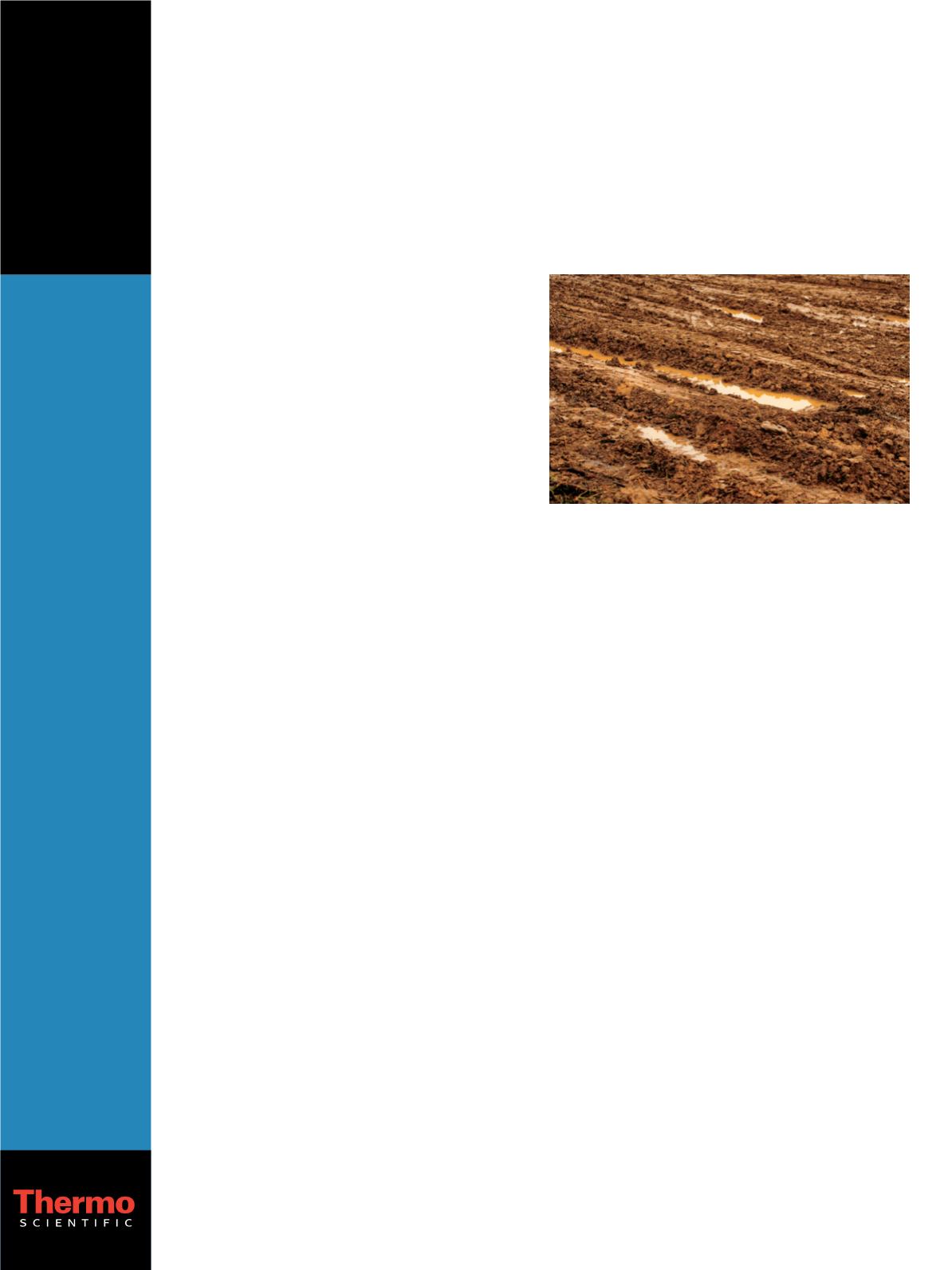

Simultaneous UHPLC/MS Analyses
of Explosive Compounds
Guifeng Jiang, Thermo Fisher Scientific, San Jose, CA, USA
Introduction
Explosive compounds, which are recognized as four major
categories, nitroaromatics, nitroamines, nitrate esters and
peroxides according to their chemical structures, are
widely used in warfare, mining industries, terrorist attacks
and civil constructions. Explosive contaminated soils are
mostly found on firing points, impact areas and training
ranges. Hexahydro-1,3,5-trinitro-1,3,5-triazine (RDX) is a
primary explosive found on the training ranges, as well as
2,4,6-trinitrotoluene (TNT), 2,6-dinitrotoluene (2,6-DNT)
and 2,4-dinitrotoluene (2,4-DNT). The explosive
contaminates in soil are possible sources for surface and
ground water contaminations, posing the environmental
and public health risks due to the compounds’ toxicity,
carcinogenicity and mutagenicity.
1,2
The increased
terrorism activities have brought the world’s attention on
explosive compounds, especially peroxide explosives.
Triacetone triperoxide (TATP) became a well known
peroxide explosive after its use by a terrorist in 2001. The
analyses of explosive compounds are demanded by the
environmental monitoring and protection agencies, crime
scene investigations and homeland securities. Explosive
analyses are challenging processes because most of the
explosive materials degrade quickly after their explosion
and the sample matrices vary from one to the other.
Furthermore, the peroxide explosives are not suitable for
UV detection because of their lack of chromophores and
their instability under the illumination of UV light.
The U.S. Environmental Protection Agency (USEPA)
method 8330 is the current standard method for the
identification of explosive compounds, which uses HPLC
separation and UV detection of nitroaromatic and
nitroamine compounds. However, the lack of selectivity of
UV detection makes compound identification in
complicate matrices ambiguous. Mass spectrometry has
been employed in TATP detection with Agilent LC/MSD
TOF instrument; however, the Agilent instrument and
method demonstrated poor sensitivity with limit of
quantitation (LOQ) at 1 mg/L.
3
In this application, we developed an ultra high
performance liquid chromatography/mass spectrometry
(UHPLC/MS) method to efficiently separate, detect and
quantitate all four classes of explosive compounds, including
eight nitroaromatics, two nitroamines, five nitrate esters
and two peroxides. The explosives were separated on a
Thermo Scientific Hypersil GOLD PFP, 1.9 µm, 2.1 x 100 mm
column and detected by selected ion monitoring (SIM) on
an Thermo Scientific MSQ Plus Mass Detector – a fast
scanning, single-quadrupole mass spectrometer.
Experimental Conditions
Standard Preparation
Hexamethylenetriperoxidediamine (HMTD), octohydro-
1,3,5,7-tetranitro-1,3,5,7-tetrazocine (HMX), hexahydro-
1,3,5-trinitro-1,3,5-triazine (RDX), ethylene glycol
dinitrate (EGDN), diethylene glycol dinitrate (DEGDN),
1,3,5-trinitrobenzene (1,3,5-TNB), 1,3-dinitrobenzene
(1,3-DNB), methyl-2,4,6-trinitrophenylnitramine (Tetryl),
4-amino-2,6-dinitrotoluene (4A-DNT), 2-amino-4,6-
dinitrotoluene (2A-DNT), nitroglycerin (NG), 2,4,6-
trinitrotoluene (TNT), 2,6-dinitrotoluene (2,6-DNT),
2,4-dinitrotoluene (2,4-DNT), pentaerythritol tetranitrate
(PETN), trimethylolethane trinitrate (TMETN), and
triacetone triperoxide (TATP) were purchased from
AccuStandard
®
(New Heaven, CT, USA) as 100 mg/L
standard solution in acetonitrile or in solid form. The
stock solutions of 1000 mg/L of RDX, TNT, Tetryl and
PETN standard were prepared by dissolving accurately
weighed solids in acetonitrile or methanol. The calibration
standards were prepared by diluting the 100 mg/L stock
solutions with water to 0.010, 0.032, 0.160, 0.800, 4.00,
and 20.00 mg/L.
Sample Preparation
Blank soil sample (San Jose, CA) was dried and
homogenized. Each 2.0 g of the dried blank soil sample
was amended with 0.04 µL, 0.2 µL, 1 µL, 2 µL and 10 µL
standard solution containing 100 mg/L RDX, TNT,
Tetryl and PETN, which corresponded to 2, 10, 50, 100
and 500 µg/kg for each analyte in soil. The amended soil
samples (2.0 g) were added to 5 mL of acetonitrile. The
solutions were capped and sonicated for 15 min. The
supernatants (3.5 mL) were transferred to a clean vial,
evaporated at 37 °C to dryness under nitrogen. The
residues were reconstituted with 200 µL acetonitrile as
samples for LC/MS analyses.
Key Words
• MSQ Plus
Mass Detector
• Explosives
• Library Spectra
• Sensitivity
• UHPLC
Application
Note: 51879



















